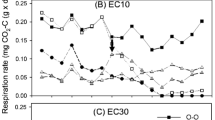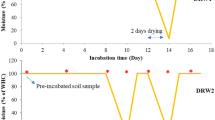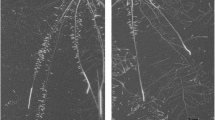Abstract
Background and aims
Soil drying negatively impacts several rhizosphere processes, but plant roots are capable of alleviating changes in rhizosphere water content by releasing mucilage. We propose that enhanced water retention in the rhizosphere due to mucilage and microbial extracellular polysaccharides allows for fast diffusion of enzymes and substrates, and thus high enzyme activity in the vicinity of roots.
Methods
To assess the effect of diffusion on enzyme activity, the relation between phosphatase activity and volumetric soil water content (VWC) was quantified in sterile soil. Then, barley plants were grown in rhizoboxes and subjected to a drying cycle, while VWC and phosphatase activity were monitored by neutron radiography and soil zymography.
Results
The relation between phosphatase activity and VWC was well described by a diffusion model (R2 = 0.64), demonstrating the importance of diffusion for enzyme activity. This finding was confirmed in the experiment with plants where phosphatase activity strongly decreased upon soil drying. Enzyme activity decreased less in the rhizosphere than in the bulk soil: the ratio between phosphatase activity in the rhizosphere and bulk soil was 10 when the soil was close to saturation and 63 when the soil contained 5% water. The relationship between phosphatase activity and local soil WC were well fitted by the diffusion model (rhizosphere: R2 = 0.54, bulk: R2 = 0.63), emphasizing the effect of diffusion on soil enzyme activity.
Conclusions
Our results indicate that soil VWC has a significant effect on soil enzyme activity by increasing diffusion of enzymes and substrate. The higher retention of water in the rhizosphere maintains high enzyme activity around roots in drying soils, which might be beneficial for plant nutrient acquisition.







Similar content being viewed by others
References
Ahmed MAA, Kröner E, Holz M, Zarebanadkouki M, Carminati A (2014) Mucilage exudation facilitates root water uptake in dry soils. J Functional Plant Biology 41:1129
Ali RS, Ingwersen J, Demyan MS, Funkuin YN, Wizemann H, Kandeler E, Poll C (2015) Modelling in situ activities of enzymes as a tool to explain seasonal variation of soil respiration from agro-ecosystems. Soil Biol Biochem 81:291–303. https://doi.org/10.1016/j.soilbio.2014.12.001
Allison, S.D., Weintraub, M.N., Gartner, T.B., Waldrop, M.P., 2011. Evolutionary-economic principles as regulators of soil enzyme production and ecosystem function 229–243. https://doi.org/10.1007/978-3-642-14225-3
Burns RG, Deforest JL, Marxsen J, Sinsabaugh RL, Stromberger ME, Wallenstein MD, Weintraub MN, Zoppini A (2013) Soil enzymes in a changing environment : current knowledge and future directions. Soil Biol Biochem 58:216–234. https://doi.org/10.1016/j.soilbio.2012.11.009
Carminati A, Vetterlein D (2013) Plasticity of rhizosphere hydraulic properties as a key for efficient utilization of scarce resources. Ann Bot 112:277–290. https://doi.org/10.1093/aob/mcs262
Carminati A, Moradi AB, Vetterlein D, Vontobel P, Lehmann E, Weller U, Vogel H-J, Oswald SE (2010) Dynamics of soil water content in the rhizosphere. Plant Soil 332:163–176. https://doi.org/10.1007/s11104-010-0283-8
Carmintati A, Benard P, Ahmed MA, Zarebanadkouki M (2017) Liquid bridges at the root-soil interface. Plant Soil 417:1–15. https://doi.org/10.1007/s11104-017-3227-8
Dennis PG, Miller AJ, Hirsch PR (2010) Are root exudates more important than other sources of rhizodeposits in structuring rhizosphere bacterial communities? FEMS Microbiol Ecol 72:313–327. https://doi.org/10.1111/j.1574-6941.2010.00860.x
FAO (2012) Coping with water scarcity: an action framework for agriculture and food security. In: Water report 38. Organization. Rome, Food and Agriculture
Feynman RP, Leighton RB, Sands M (1965) The Feynman lectures on physics, vol 3. Addison-Wesley, Reading, MA
George TS, Gregory PJ, Wood M, Read D, Buresh RJ (2002) Phosphatase activity and organic acids in the rhizosphere of potential agroforestry species and maize. Soil Biol Biochem 34:1487–1494. https://doi.org/10.1016/S0038-0717(02)00093-7
Grando S, Gomez MH (2005) Food barley: importance, uses, and local knowledge. International Center for Agricultural Research in the Dry Areas, Aleppo, Syria
Gregory PJ (2006) Roots, rhizosphere and soil: the route to a better understanding of soil science? Eur J Soil Sci 57:2–12. https://doi.org/10.1111/j.1365-2389.2005.00778.x
Guber A, Kravchenko A, Razavi BS, Uteau D, Peth S, Blagodatskaya E, Kuzyakov Y (2018) Quantitative soil zymography : mechanisms , processes of substrate and enzyme diffusion in porous media. Soil Biol Biochem 127:156–167. https://doi.org/10.1016/j.soilbio.2018.09.030
Holz M, Zarebanadkouki M, Kuzyakov Y, Pausch J, Carminati A (2017) Root hairs increase rhizosphere extension and carbon input to soil. Ann Bot 121:61–69. https://doi.org/10.1093/aob/mcx127
Holz M, Zarebanadkouki M, Kaestner A, Kuzyakov Y, Carminati A (2018) Rhizodeposition under drought is controlled by root growth rate and rhizosphere water content. Plant Soil 423:429–442. https://doi.org/10.1007/s11104-017-3522-4
Jones DL, Hinsinger P (2008) The rhizosphere: complex by design. Plant Soil 312:1–6. https://doi.org/10.1007/s11104-008-9774-2
Koch A (1990) Diffusion: the crucial process in many aspects of the biology of Bacteria. In: Marshall K (ed) Advances in microbial ecology. Springer, Boston, MA, pp 37–70
Landi L, Valori F, Ascher J, Renella G, Falchini L, Nannipieri P (2006) Root exudate effects on the bacterial communities, CO2 evolution, nitrogen transformations and ATP content of rhizosphere and bulk soils. Soil Biol Biochem 38:509–516
Lobet G, Pagès L, Draye X (2011) A novel image-analysis toolbox enabling quantitative analysis of root system architecture. Plant Physiol 157:29 LP–29 39
Manzoni S, Schimel JP, Porporato A, Manzoni S, Schimel JP, Porporato A (2012) Responses of soil microbial communities to water stress: results from a meta-analysis. Ecology 93:930–938
Manzoni S, Schaeffer SM, Katul G, Porporato A, Schimel JP (2014) A theoretical analysis of microbial eco-physiological and diffusion limitations to carbon cycling in drying soils. Soil Biol Biochem 73:69–83. https://doi.org/10.1016/j.soilbio.2014.02.008
McCully ME, Boyer JS (1997) The expansion of maize root-cap mucilage during hydration. 3. Changes in water potential and water content. Physiol Plant 99:169–177. https://doi.org/10.1034/j.1399-3054.1997.990123.x
Menon M, Robinson B, Oswald SE, Kaestner A, Abbaspour KC, Lehmann E, Schulin R (2007) Visualization of root growth in heterogeneously contaminated soil using neutron radiography. Eur J Soil Sci 58:802–810. https://doi.org/10.1111/j.1365-2389.2006.00870.x
Moldrup P, Olesen T, Komatsu T, Schjonning P, Rolston DE (2001) Tortuosity , diffusivity , and permeability in the soil liquid and gaseous phases. Soil Sci Soc Am J 65:613–623
Nannipieri, P., Giagnoni, L., Landi, L., Renella, G., 2011. Role of phosphatase enzymes in soil, in: Bünemann E., Oberson A., F.E. (Ed.), Phosphorus in action. Springer, Berlin, Heidelberg, pp. 215–243
Neumann G, George TS, Plassard C (2009) Strategies and methods for studying the rhizosphere-the plant science toolbox. Plant Soil 321:431–456. https://doi.org/10.1007/s11104-009-9953-9
North GB, Nobel PS (1997) Drought-induced changes in soil contact and hydraulic conductivity for roots of Opuntia ficus-indica with and without rhizosheaths. Plant Soil 191:249–258. https://doi.org/10.1023/A:1004213728734
Oburger E, Schmidt H (2015) New methods to unravel rhizosphere processes. Trends in Plant Science xx 21:1–13. https://doi.org/10.1016/j.tplants.2015.12.005
Or, D., Phutane, S., Dechesne, A., Ection, S.P.S., 2007. Extracellular Polymeric Substances Affecting Pore-Scale Hydrologic Conditions for Bacterial Activity in Unsaturated Soils 6. https://doi.org/10.2136/vzj2006.0080
Raab TK, Lipson DA, Monson RK (1999) Soil amino acid utilization among species of the Cyperaceae: plant and soil processes. Ecology 80:2401–2419
Razavi BS, Zarebanadkouki M, Blagodatskaya E (2016) Soil Biology & Biochemistry Rhizosphere shape of lentil and maize : spatial distribution of enzyme activities. Soil Biol Biochem 96:229–237. https://doi.org/10.1016/j.soilbio.2016.02.020
Rejsek K, Vranova V, Pavelka M, Formanek P (2012) Acid phosphomonoesterase (E .C .3.1.3.2) location in soil. J Plant Nutr Soil Sci 175:196–211. https://doi.org/10.1002/jpln.201000139
Richardson AE, Barea JM, McNeil AM, Prigent-Combaret C (2009) Acquisition of phosphorus and nitrogen in the rhizosphere and plant growth promotion by microorganisms. Plant Soil 321:305–339. https://doi.org/10.1007/s11104-009-9895-2
Richter GM, Semenov MA (2005) Modelling impacts of climate change on wheat yields in England and Wales : assessing drought risks. Agric Syst 84:77–97. https://doi.org/10.1016/j.agsy.2004.06.011
Roberson EB, Firestone MK (1992) Relationship between desiccation and exopolysaccharide production in a soil Pseudomonas sp. Appl Environ Microbiol 58:1284–1291
Sanaullah, M., Blagodatskaya, E., Chabbi, A., Rumpel, C., Kuzyakov, Y., 2011. Drought effects on microbial biomass and enzyme activities in the rhizosphere of grasses depend on plant community composition. Applied Soil Ecology 48:38–44. https://doi.org/10.1016/j.apsoil.2011.02.004
Sardans J, Peñuelas J (2005) Drought decreases soil enzyme activity in a Mediterranean Quercus ilex L. forest. Soil Biol Biochem 37:455–461. https://doi.org/10.1016/j.soilbio.2004.08.004
Soille P (2003) Morphological image analysis: principles and applications. Spiringer Verlag, Germany
Spohn M, Kuzyakov Y (2013a) Phosphorus mineralization can be driven by microbial need for carbon. Soil Biol Biochem 61:69–75. https://doi.org/10.1016/j.soilbio.2013.02.013
Spohn M, Kuzyakov Y (2013b) Distribution of microbial-and root-derived phosphatase activities in the rhizosphere depending on P availability and C allocation–coupling soil zymography with 14C imaging. Soil Biol Biochem 67:106–113
Spohn M, Kuzyakov Y (2014) Spatial and temporal dynamics of hotspots of enzyme activity in soil as affected by living and dead roots—a soil zymography analysis. Plant Soil 379:67–77. https://doi.org/10.1007/s11104-014-2041-9
Spohn M, Carminati A, Kuzyakov Y (2013) Soil zymography - a novel in situ method for mapping distribution of enzyme activity in soil. Soil Biol Biochem 58:275–280. https://doi.org/10.1016/j.soilbio.2012.12.004
Steinweg JM, Dukes JS, Wallenstein MD (2012) Modeling the effects of temperature and moisture on soil enzyme activity: linking laboratory assays to continuous field data. Soil Biol Biochem 55:85–92. https://doi.org/10.1016/j.soilbio.2012.06.015
Tarafdar JC, Claassen N (1988) Organic phosphorus compounds as a phosphorus source for higher plants through the activity of phosphatases. Biol Fertil Soils 5:308–312. https://doi.org/10.1007/BF00262137
Tarafdar JC, Jungk A (1987) Phosphatase activity in the rhizosphere and its relation to the depletion of soil organic phosphorus. Biol Fertil Soils 3:199–204. https://doi.org/10.1007/BF00640630
Trenberth KE, Dai A, Van Der Schrier G, Jones PD, Barichivich J, Briffa KR, Sheffield J (2014) Global warming and changes in drought. Nat Clim Chang 4:17–22. https://doi.org/10.1038/nclimate2067
Volk E, Iden SC, Furman A, Durner W, Rosenzweig R (2016) Biofilm effect on soil hydraulic properties: experimental investigation using soil-grown real biofilm. Water Resour Res 52:5813–5828. https://doi.org/10.1002/2016WR018866
Wilhelmi OV, Wilhite DA (2002) Assessing vulnerability to agricultural drought : a Nebraska case study. Nat Hazards 25:37–58
Young IM (1995) Variation in moisture contents between bulk soil and the rhizosheath of wheat (Triticum aestivum L . cv . Wembley). New Phytol 130:135–139
Zarebanadkouki M, Kim YX, Moradi AB, Vogel H-J, Kaestner A, Carminati A (2012) Quantification and modeling of local root water uptake using neutron radiography and deuterated water. Vadose Zone J 11. https://doi.org/10.2136/vzj2011.0196
Zarebanadkouki M, Ahmed MA, Carminati A (2016) Hydraulic conductivity of the root-soil interface of lupin in sandy soil after drying and rewetting. Plant Soil 398:267–280. https://doi.org/10.1007/s11104-015-2668-1
Zheng W, Zeng S, Bais H, LaManna JM, Hussey DS, Jacobson DL, Jin Y (2018) Plant growth-promoting Rhizobacteria (PGPR) reduce evaporation and increase soil water retention. Water Resour Res 54:3673–3687. https://doi.org/10.1029/2018WR022656
Zhu J, Qu B, Li M (2017) Phosphorus mobilization in the Yeyahu wetland: phosphatase enzyme activities and organic phosphorus fractions in the rhizosphere soils. Int Biodeterior Biodegradation 124:304–313. https://doi.org/10.1016/j.ibiod.2017.05.010
Acknowledgements
We thank Bea Burak and Ian Dodd for providing the seeds for the experiments and Joscha Becker for advice concerning the statistical analysis. MH thanks Bahar S. Razavi for introducing her to the zymography method. The authors acknowledge the German Research Foundation for granting the projects CA 921/3-1, KU 1184/33-1 and SP1389/6-1, and the ev. Studienwerk Villigst for granting a stipend for MH.
Author information
Authors and Affiliations
Corresponding author
Additional information
Responsible Editor: Tim S. George.
Publisher’s note
Springer Nature remains neutral with regard to jurisdictional claims in published maps and institutional affiliations.
Electronic supplementary material
ESM 1
(DOCX 437 kb)
Rights and permissions
About this article
Cite this article
Holz, M., Zarebanadkouki, M., Carminati, A. et al. Increased water retention in the rhizosphere allows for high phosphatase activity in drying soil. Plant Soil 443, 259–271 (2019). https://doi.org/10.1007/s11104-019-04234-3
Received:
Accepted:
Published:
Issue Date:
DOI: https://doi.org/10.1007/s11104-019-04234-3




